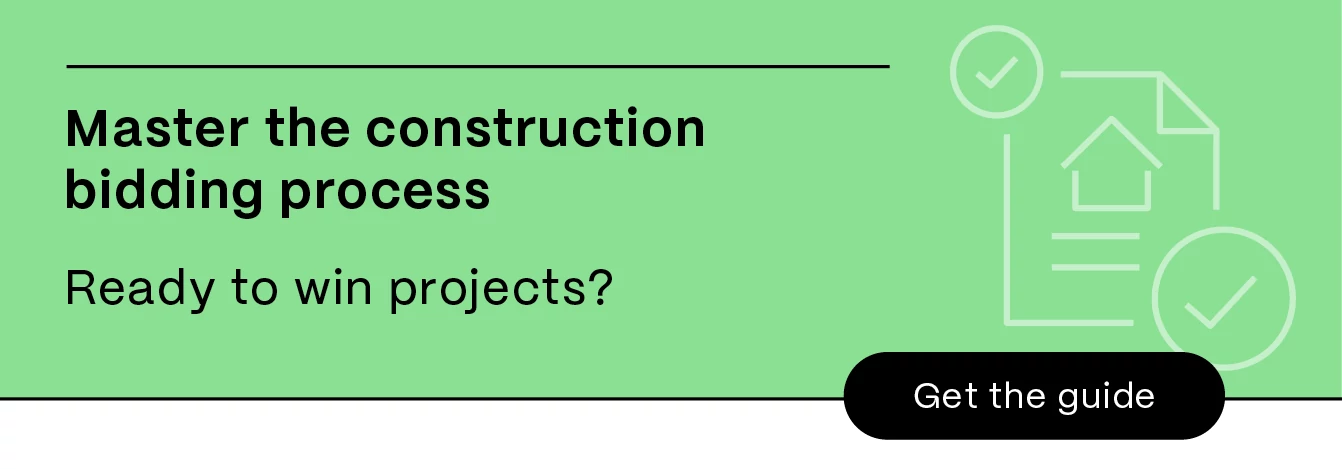
Blog
5 construction project phases: insights and best practices

The construction industry is booming, with U.S. spend on new construction projects expected to reach $2.3 trillion by 2028. This growth brings with it more competition for jobs, making the need to deeply understand every aspect of the construction project lifecycle more important than ever. From initial concept to the final handover, each stage presents distinct challenges and opportunities.
This guide outlines the five key construction project phases, providing valuable insights and best practices for successful project management at each stage.

What is project management in the construction industry?
Construction project management is the comprehensive process of planning, organizing, and overseeing every aspect of the construction project lifecycle. It involves coordinating a complex network of resources, tasks, and personnel to ensure that work is delivered on time, within budget, and to the highest quality standards.
The construction project management life cycle includes initiation, planning, execution, monitoring, and closing. With guidance at each of these stages, you can streamline operations, strengthen your reputation, foster greater client satisfaction, and position your business for growth in this highly competitive market.
What is the project team in construction management?
Before diving into the specific construction project phases, it’s important to understand the typical team structure. Each member brings their own specialized skills to the table, but the project’s success hinges on the team’s collective effort. By encouraging open collaboration and communication, crews can better navigate complex projects and achieve desired outcomes.
A usual construction project team includes:
- Owner/client: The person or group funding the venture and responsible for making major decisions.
- Architect: Develops the design and plans for the building.
- Building inspector: Verifies that the building meets various codes and regulations.
- Project manager: Plays a pivotal role in keeping things on course and addressing challenges. They oversee the entire project, coordinate teams, manage resources, and make sure the plan is followed.
- Superintendent: Serves as the eyes and ears on the ground, important for identifying and resolving issues promptly. The site superintendent manages on-site activities, supervises subcontractors, and enforces safety regulations.
- Foremen: Leads specific trade teams, coordinates daily tasks, and reports progress to the superintendent. They’re a key link between workers and management.
- Subcontractors: Specializes in specific tasks within their areas of expertise. Given they enter at key times of the build, their timely work is essential for maintaining schedules.
- Safety manager: Prevents accidents and confirms a safe working environment for all by enforcing safety regulations and implementing safety programs.
- Quality control manager: Stops costly errors and ensures client satisfaction by conducting regular inspections and verifying work meets specified standards.
- Procurement manager: Manages material and equipment delivery schedules, crucial for preventing delays caused by material or equipment shortages.
- Project engineer: Provides technical support, review submittals, and assist in problem-solving. They’re invaluable for resolving complex engineering challenges that may arise during construction.
Phase 1: project initiation
The project initiation phase lays the groundwork for the entire job. It defines the scope, objectives, and feasibility. During this stage, the initial idea evolves into a concrete plan. This ensures that all stakeholders have a clear understanding of the project’s requirements before investing time, money, and resources.
Key activities
- Concept development: Refine the initial idea, considering factors such as market demand, location, and potential profitability.
- Feasibility study:Evaluate the technical, financial, and legal viability of a project, including a site assessment, market research, and cost estimation.
- Project charter creation: Develop a formal document outlining the project’s purpose, objectives, scope, and deliverables. This charter serves as a guide for all parties involved.
- Initial risk assessment: Identify potential risks and opportunities that could impact the outcome of a project.
- Preliminary budget and schedule: Create high-level estimates for costs and timelines.
Best practice tips for success
- Set measurable objectives: Define specific, achievable, and time-bound (SMART) goals. Clear objectives provide direction, facilitate decision-making, and make it easy to track project progress effectively.
- Use data to make decisions: Making decisions based on data can lead to better results and help clients see the reasoning behind your choices. Use market research, past data, and analytics to steer your project decisions.
- Create a strong communication plan: Clear communication channels help prevent misunderstandings, reduce delays, and promote a positive working environment. From the beginning of a project, outline how information will be shared among team members and stakeholders in a documented plan.
Phase 2: project planning
The project planning phase involves creating a detailed blueprint and timeline for project execution. Effective planning is crucial for preventing scope creep, controlling costs, and keeping everyone aligned on goals and expectations.
Detailed steps
- Create a detailed project timeline: Develop a schedule that outlines all activities, milestones, and deadlines. Use Gantt charts and critical path analyses for enhanced visualization and tracking.
- Establish a realistic budget: Outline all expenses, including materials, labor, equipment, and overhead to inform an accurate budget.
- Develop a risk management plan: Identify potential risks and set up strategies to mitigate them, preventing future bottlenecks.
- Clarify roles and responsibilities: Clearly define the duties of each team member and subcontractor to maintain accountability.
- Create a resource allocation plan: Determine the materials, equipment, and workforce that will be required at each phase of the project.
- Develop quality control measures: Establish quality standards and create inspection checklists to ensure consistency throughout the project.
Related read:Master the construction bidding process: a complete guide

Best practice tips for success
- Embrace digital planning tools: Use project management software and collaborative platforms to streamline workflow processes and facilitate information sharing. Digital tools enhance efficiency, reduce errors, and provide real-time visibility into project status.
- Create a dedicated hub: Set up aclient portal to simplify the onboarding process and streamline the submission, sharing, and signing of documents between teams.
- Develop document templates: Build a template library to make it easier to draft and share repetitive documents.
Phase 3: project execution
At this stage, the real work begins. Project execution involves putting the project plan into action, coordinating teams and resources, and managing day-to-day operations to make the project a reality. Strong coordination between teams helps everything run smoothly, which is critical to avoiding setbacks and ensuring the project meets the client’s expectations.
Best practice tips for success
- Use real-time progress tracking: Employ digital tools to monitor and report progress in real time. This way, you can spot delays or issues early and address them quickly.
- Keep the schedule updated: Regularly adjust the project timeline based on how things are actually progressing. This helps you catch potential setbacks early and make proactive changes to stay on track.
- Maintain detailed documentation: Keeping thorough records is critical for resolving disputes, managing client expectations, and extracting lessons learned for future projects. Keep records of all decisions, changes, and progress.
Phase 4: project monitoring and control
The project monitoring phase operates in tandem with execution to make sure everything stays on track with the project’s scope, timeline, and budget. This phase involves regularly tracking progress, comparing it to the original plan, and making adjustments as needed. Effective monitoring helps protect against scope creep, cost overruns, and schedule delays — enabling project managers to make informed decisions and take corrective actions when necessary.
Key metrics
- Earned value (EV): Measures the actual value of work completed so far. This number is important for understanding project progress in terms of both time and budget.
- Schedule performance index (SPI): Compares the amount of work done to what was planned. An SPI below 1.0 means the project is behind schedule, signaling the need to identify and address delays quickly.
- Cost performance index (CPI): Compares planned costs to actual expenses. A CPI below 1.0 means the project is over budget, prompting a review of the plan to find cost-saving measures.
- Actual cost (AC): Tracks the total expenses incurred for completed work. This metric is essential for keeping costs under control and forecasting final project costs.
- Planned value (PV): Represents the planned cost for scheduled work. Comparing PV with EV and AC provides insights into the project’s schedule and cost performance.
Best practice tips for success
- Conduct regular project status meetings: Hold weekly meetings to discuss progress, challenges, and next steps. This ensures all team members are informed and held accountable.
- Use visual management tools: Employ dashboards and visual charts to display key metrics. Visualizations help you better identify trends and issues, enabling faster responses.
- Establish clear thresholds for corrective action: Define specific trigger points for initiating intervention. This promotes more consistent decision-making and ensures timely responses to project changes.
Phase 5: project closure
Project closure is the final stage of the construction project management lifecycle, marking the completion of construction and the formal transfer of ownership to the client. During this phase, teams finalize inspections, address punch list items, and conclude all financial matters, including final payment and closing the budget. As part of this phase, teams compile and organize all relevant documentation — such as as-built drawings, warranties, and maintenance manuals — for handover to the client.
Lessons learned
Conducting a comprehensive post-project review involves examining the entire construction project lifecycle to identify areas of success, failure, and potential improvement. The insights gained from this review can help refine future work and improve your team’s processes.
Best practice tips for success
- Develop a closure checklist: Create a detailed list of all necessary tasks to ensure a thorough and consistent closure process.
- Conduct a wrap session: Gather key stakeholders to discuss their thoughts and takeaways. This fosters a shared understanding of successes and areas for improvement.
- Create and distribute a final report: Summarize key outcomes, challenges, and lessons learned. A formal report informs stakeholders about the results and serves as a valuable reference for future projects.
Mastering construction project management life cycles
Construction teams can significantly elevate their outcomes by mastering each construction project phase and following management best practices. This approach not only ensures one-off project success but also fosters long-term organizational growth and client relationships.
Remember that the construction industry is always evolving, with new technologies and methods regularly coming into play. Staying current with industry trends and being ready to adapt your processes is important for keeping a competitive edge. If you're prepared to get started, consider exploring construction project management solutions to find the one that works best for you.
Related Resources
